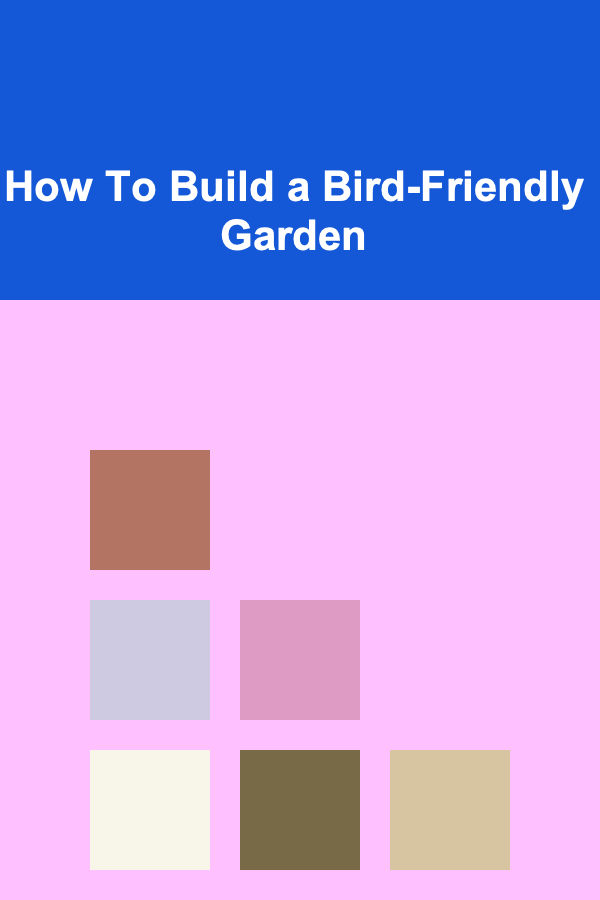
How To Build a Bird-Friendly Garden
ebook include PDF & Audio bundle (Micro Guide)
$12.99$10.99
Limited Time Offer! Order within the next:

Creating a bird-friendly garden is one of the most rewarding ways to engage with nature while enhancing the biodiversity of your home environment. Birds provide beauty, sound, and natural pest control, and they are an essential part of any healthy ecosystem. By transforming your garden into a safe and welcoming habitat for birds, you not only contribute to the protection of local wildlife but also experience the joy of birdwatching right in your backyard. In this guide, we will explore the steps and strategies you can take to build a bird-friendly garden that attracts a wide variety of bird species.
Why Build a Bird-Friendly Garden?
Before diving into the practical steps of building a bird-friendly garden, it's essential to understand the importance of birds in our environment. Birds play several vital roles, such as:
- Pollinators and Seed Dispersers: Many bird species help pollinate flowers and spread seeds, promoting plant diversity and healthy ecosystems.
- Pest Control: Birds consume a wide range of insects and pests, reducing the need for chemical pesticides in gardens.
- Biodiversity Boosters: Birds support the balance of food webs and contribute to the overall health of ecosystems.
- Cultural and Aesthetic Value: Birds bring beauty, color, and song to the garden, providing enjoyment and enhancing the natural ambiance.
Building a bird-friendly garden can significantly enhance your outdoor space while contributing positively to environmental conservation efforts.
Steps to Create a Bird-Friendly Garden
1. Choose the Right Plants for Birds
Selecting the right plants is the foundation of a bird-friendly garden. Native plants are particularly beneficial because they provide the food, shelter, and nesting materials that local bird species require. Native plants are adapted to the local climate and ecosystem, meaning they offer the best chance for attracting native birds.
Types of Plants to Include:
- Berry-producing shrubs: These plants are ideal for attracting frugivorous (fruit-eating) birds. Examples include elderberries, holly, and viburnum.
- Flowering plants: Many birds, especially hummingbirds, are attracted to nectar-rich flowers. Consider adding plants such as bee balm, columbine, and trumpet vine.
- Trees for cover and nesting: Tall trees like oak, pine, and maple provide essential shelter and nesting sites for many bird species.
- Seed-bearing plants: Sunflowers, coneflowers, and asters produce seeds that attract birds like finches, sparrows, and cardinals.
- Grasses and reeds: Grasses like switchgrass and sedges offer nesting sites for ground-nesting birds and provide cover.
Incorporating a variety of plants with different flowering and fruiting times will ensure that birds have food and shelter throughout the year.
2. Provide Fresh Water Sources
Birds need water for drinking and bathing, so having a water feature in your garden is essential. A birdbath or a small pond can provide the perfect watering hole. Birds use water not only for hydration but also for cleaning their feathers, which helps with insulation and flight.
When installing a water feature, consider the following:
- Depth: Shallow water is better for most birds. Ensure that the water in your birdbath or pond is no more than 2-3 inches deep.
- Cleanliness: Birds will avoid dirty water, so it's essential to clean the water feature regularly. Use a non-toxic cleaner and scrub away any algae buildup.
- Accessibility: Place the water source in a quiet, safe location to minimize the risk of predators, such as cats, and provide a secure perch where birds can rest and drink.
A birdbath with a gentle dripper or a small fountain can also provide moving water, which is particularly attractive to birds like sparrows and robins.
3. Provide Shelter and Nesting Sites
Birds need shelter to protect them from predators and the elements. You can provide shelter through dense shrubbery, trees, and other plants that offer protection. However, for many species, providing dedicated nesting sites is crucial.
Nesting Options:
- Birdhouses: Install birdhouses to give cavity-nesting birds a place to raise their young. Ensure that the birdhouse is appropriate for the species you're trying to attract. For example, chickadees prefer small entrances, while bluebirds need a larger hole.
- Nesting Materials: Many birds gather natural materials to build their nests. You can help by offering nesting materials such as twigs, straw, cotton, or even pet hair. Placing a small basket or pile of materials in a corner of your garden can encourage birds to use them.
Be mindful of the placement of birdhouses. They should be positioned away from predators like cats and squirrels and ideally located in quiet areas of the garden.
4. Create a Safe Habitat
One of the most important aspects of a bird-friendly garden is ensuring that birds feel safe. Gardens filled with predators, noisy areas, or excessive disturbance will not attract birds. Here are some ways to increase the safety of your garden for birds:
- Avoid pesticides: Chemical pesticides can be harmful to birds and the insects they feed on. Opt for organic gardening methods or use natural pest control techniques like companion planting or beneficial insects.
- Provide cover: Dense shrubbery, tall grasses, and trees provide birds with places to hide from predators. By adding these layers of cover, you give birds a sense of security and a place to retreat when they feel threatened.
- Avoid outdoor cats: Cats are one of the biggest predators of birds, especially ground-nesting species. Keep your garden safe by ensuring that any outdoor cats are kept indoors or in enclosed cat patios (catios) that prevent them from hunting birds.
A safe garden allows birds to thrive and return year after year.
5. Offer Bird Feeders
Bird feeders are a great addition to a bird-friendly garden. They provide supplemental food, especially during the winter months when natural food sources may be scarce. Different types of feeders attract different bird species, so it's beneficial to have a variety of feeders available.
Types of Bird Feeders:
- Tube feeders: These are ideal for small songbirds like finches and chickadees. They can be filled with sunflower seeds, safflower seeds, or mixed seed blends.
- Hopper feeders: Larger birds, such as cardinals, jays, and woodpeckers, are more likely to use hopper feeders. These feeders can hold larger amounts of seed and accommodate a variety of bird species.
- Suet feeders: Suet is a high-energy food that is particularly beneficial in the colder months. Suet feeders attract woodpeckers, nuthatches, and other insect-eating birds.
- Nyjer seed feeders: Nyjer seeds are particularly attractive to finches, especially goldfinches. A special thistle sock or tube feeder is used to dispense these small seeds.
When placing bird feeders, keep them away from places where predators can lurk, such as near bushes or trees with easy access for cats.
6. Provide a Variety of Food Sources
In addition to bird feeders, consider offering a variety of natural food sources for birds to forage. This can include:
- Fruit-bearing plants: Plants like apple trees, cherries, or grapes can provide fresh fruit for birds.
- Nuts and seeds: Sunflower seeds, peanuts, and other nuts are attractive to a wide range of birds.
- Insects: Many birds feed on insects, especially during the breeding season. By avoiding pesticides, you can naturally attract more bugs for birds to eat.
7. Consider the Garden's Design
The layout of your garden can also impact how bird-friendly it is. A well-designed garden with varied plant heights, multiple layers, and open spaces encourages a diverse range of bird species.
Design Tips:
- Layered planting: Include a mix of ground cover, shrubs, small trees, and large trees to create different levels of shelter and food sources.
- Open space for flight: Birds need space to fly in and out of your garden, so don't overcrowd your plants. Provide open spaces where birds can feel free to move without obstruction.
- Avoid using lawn monocultures: A large, flat lawn with just one type of grass provides little for birds. Instead, focus on creating diverse habitats with a variety of plants and groundcovers.
The more diverse your garden, the more likely you are to attract different bird species.
Conclusion
Building a bird-friendly garden is an incredibly rewarding and sustainable way to engage with nature. By providing the right plants, water sources, shelter, and food options, you can create a haven for birds that supports biodiversity and encourages the return of birdlife year after year. Additionally, a bird-friendly garden offers you the chance to observe a variety of bird species, enhancing your connection to the natural world. Whether you're a seasoned gardener or just getting started, transforming your space into a bird sanctuary is a project worth pursuing.
Reading More From Our Other Websites
- [Home Rental Property 101] How to Find Houses for Rent with a Home Gym That Fits Your Budget
- [Whitewater Rafting Tip 101] Gear Up! Essential Equipment for Conquering Waterfall Rapids
- [Personal Financial Planning 101] How to Use Credit Cards Wisely to Build Credit and Rewards
- [Home Pet Care 101] How to Set Up In-Home Dog Care for Your Pet's Comfort
- [Home Rental Property 101] How to Design a Functional Mudroom in Houses for Rent with a Mudroom: Storage Solutions and Organization Hacks
- [Personal Finance Management 101] How to Manage Student Loans Effectively While Still Saving for the Future
- [Personal Care Tips 101] How to Choose a Budget-Friendly Body Butter That Works Wonders
- [Home Space Saving 101] How to Save Space in a Studio Apartment with Simple Solutions
- [Organization Tip 101] How to Find Second-Hand Storage Solutions for Your Garage
- [Horseback Riding Tip 101] Best Beginner Horseback Riding Experiences: A Step‑by‑Step Guide for First‑Time Riders

How to Analyze SMS Abandoned Cart Recovery Campaigns for Dropshipping Success
Read More
How to Create a Checklist for Packing for Your Vacation
Read More
How to Make Passive Income Through Deep Learning SaaS Solutions
Read More
How to Stage a Home During Different Seasons for Maximum Impact
Read More
How to Analyze the Symbolism of Props in Film
Read More
Advanced Instant Pot Mastery: Beyond the Basics
Read MoreOther Products

How to Analyze SMS Abandoned Cart Recovery Campaigns for Dropshipping Success
Read More
How to Create a Checklist for Packing for Your Vacation
Read More
How to Make Passive Income Through Deep Learning SaaS Solutions
Read More
How to Stage a Home During Different Seasons for Maximum Impact
Read More
How to Analyze the Symbolism of Props in Film
Read More